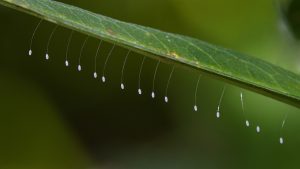Insect biomimicry may lead to a new wave of high-grade, lightweight plastics
A new wave of performance materials for the aerospace and automotive sectors may be round the corner thanks to the discovery of a new biofibre.
Researchers at the Fraunhofer Institute for Applied Polymer Research have developed a range of new rigid and stable biofibres made from silk protein.

The silk protein stems from a family of chysopidae insects; Green Lacewings. The silk protein is used as a stable thread from which the insects hang their eggs on the underside of leaves – safe from the reach of predators.
Researchers found that the super-strong and stable substance was created by the insect secreting a protein substance onto the leaf. The egg is then laid in the deposit and pulled out from the leaf. The resulting silk thread hardens in the air.
The process used by Green Lacewings to safeguard their eggs can be found in a number of other similar insects, however the rigidity and stability of the Lacewing’s silk fibre is unique. Biologists at the Fraunhofer IAP are now in the process of using biomimicy to create a man-made, commercially viable version of this performance material.
At present it has proved difficult to produce the silk protein in sufficient quantities and purities. However, it is hoped that through collaboration with AMSilk and biomaterial researchers at the University of Bayreuth, a practical solution for the manufacture of silk protein can be achieved.
Should a cost effective means of reliably producing silk protein be developed, researchers expect the performance material to be used in a variety of aerospace and automotive applications.
Biomimicry in surface engineering
At Surface Technology we believe that in order to continue advancing surface engineering, great strides can be made through biomimicry; by better understanding how living organisms have evolved to meet their environmental challenges.
Over the course of 2017 we will continue to look at the natural world as a driver for surface engineering innovations and improvements. From fish to amphibians and plants to arachnids, we will put nature under the surface engineering lens in our Biomimicry in Surface Engineering series, published in this blog. You can also make sure you don’t miss an issue by registering below to receive our monthly surface engineering update.
Contact us now for a quote or to discuss your surface engineering requirements further.
Register below for our monthly email and stay up-to-date with the latest surface engineering white papers, case studies and innovation news.

